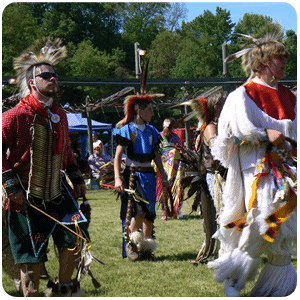Native Americans inhabited the French Creek Valley from Archaic to Late Woodland times, an era spanning the period from 1,000 years before the birth of Christ to 1,000 years after. Archaeologists have excavated prehistoric village sites and burial mounds at Wilson Shutes, south of Meadville, PA, and at the McFate Farm in Cochranton, PA, the region’s most extensively investigated location.

Native settlement and subsistence in the watershed were largely determined by environmental factors that included pigeon roosts, deer licks, waterfowl migrations, nut groves, soil character and river riffles. Hunting, fishing, and foraging were principal occupations. However, fire management was also a critical survival tool. Natives burned woodlands to create large meadows and prairies that supported the growth of natural grasses and plants suitable for food and fiber and to attract and sustain wildlife, particularly deer. These areas were a prominent part of the landscape upon the arrival of Europeans. Noteworthy examples occur on French Creek near the confluence of Cussewago and LeBoeuf Creeks, and several mid-eighteenth century accounts report their existence from the mouth French Creek to Lake LeBoeuf. Washington’s 1753 journal noted “several extensive and very rich meadows, one of which, I believe was nearly four miles in length and considerably wide in some places.” A 1760 record kept by Colonel Henry Bouquet, a prominent British officer during the French and Indian War, includes a description of a prairie south of Meadville as “the richest Meadows I ever saw, quite clear more than Two Miles in length & half a Mile Broad.”
Tribal affiliations of natives in the watershed were primarily Seneca, members of the Iroquois Confederacy, and the Lenape, or Delaware Tribe, an Algonquian people who were displaced from eastern Pennsylvania in the 18th century by progressive European encroachment. The largest native settlement in the French Creek Valley was a Delaware village, Custaloga’s Town, located at the confluence of French Creek and North Deer Creek in Mercer County, PA. Another was located at the mouth of the Cussewago River. John Reynolds, one of the earliest European settlers in the region, described the native activities he observed:
“The fall and winter of 1798-99 we had in close proximity several Indian camps, they supplied us with meat; in that day they overspread this region. It was their favorite hunting land on every little stream they made their encampment, and hunted and trapped through autumn and winter; in the spring they returned their towns and through the summer scattered along the river fishing and watching deer licks, while the squaws raised a little corn and some vegetables, dressing deerskins and made moccasins…”
During the seventeenth century many of the people in the watershed were dispersed by intertribal warfare and the region was only sparsely populated. With the arrival of Europeans, native tribes formed political and military alignments with the French or various English colonies, and were inevitably drawn into the conflict that culminated in the French and Indian, or Seven Years War, waged from 1754 to 1763.


